February 6, 2009
Air Date: February 6, 2009
FULL SHOW
SEGMENTS
Toward a Green Recovery
/ Jeff YoungView the page for this story
The economic stimulus could generate green jobs with tens of billions of dollars for clean energy and efficiency. Labor and environmental groups want to make sure those jobs pay people well as they do good for the planet. Living on Earth¹s Jeff Young says that means engaging in tough fights over free trade and fair wages. (06:30)
Electric Green Jobs
View the page for this story
President Obama's stimulus plan could mean thousands of jobs for qualified electricians and money for training apprentices. Michael Callanan, executive director of the National Joint Apprenticeship Training Committee, tells host Bruce Gellerman that investing in renewable energy and energy efficiency is a win for the environment and for blue collar workers. (05:30)
Gender and Climate Change
View the page for this story
According to one international environmental group, women will be particularly affected by the predicted increase in climate change-related disasters. Lorena Aguilar, the senior gender advisor with the International Union for the Conservation of Nature, tells host Bruce Gellerman that floods, droughts and hurricanes will hit women and the poor hardest. (06:05)
Darwin the Abolitionist
View the page for this story
Two-hundred years after his birth, a new biography sets out to portray Charles Darwin as a passionate moralist engaged in a scientific war on the prevailing racism of the day. James Moore, author of "Darwin's Sacred Cause," talks with host Bruce Gellerman about how the scream of a tortured slave drove Darwin to develop his theory of evolution—and helped discount the scientifically-accepted belief that blacks and whites belonged to different species. (08:15)
Salt Marsh Diary
View the page for this story
Writer Mark Seth Lender observes a flock of mallards on a Connecticut river bend. (03:00)
Burning Controversy
View the page for this story
In these hard economic times, an increasing number of homeowners are installing outdoor wood boilers to heat their homes. In Maine, where wood is plentiful and burning wood is a tradition, smoke from the devices ignited a firestorm of controversy, pitting neighbor against neighbor. Host Bruce Gellerman investigates the case for and against outdoor wood boilers. (17:00)
Show Credits and Funders
Show Transcript
Host: Bruce Gellerman
Guests: Lorena Aguilar, Michael Callanan, James Moore
Reporters: Jeff Young
Commentator: Mark Seth Lender
[THEME]
GELLERMAN: From Public Radio International - this is Living on Earth.
[THEME]
GELLERMAN: I’m Bruce Gellerman.
Turning greenbacks into green jobs for blue collar workers:
CALLANAN: We’ve suffered in the construction industry from this mantra over the last ten or fifteen years that your sons and daughters aren’t going to be successful unless they go to college – we’re taking people from flipping burgers one day and the next day we’ve got them in to a full-blown four year career in an apprenticeship system.
GELLERMAN: Economic insulation for aspiring electricians.
Also – commemorating the scientist whose theory is said to be the single best idea anyone’s ever had. It was inspired by the worst injustice.
MOORE: Until Darwin reached South America he had a theoretical understanding of slavery and its horrors, but when he got to South America he put shredded flesh on that slave. He saw the instruments of torture, he heard the screams.
GELLERMAN: These stories - this week on Living on Earth. Stick Around!
[NEWSBREAK MUSIC: Boards Of Canada “Zoetrope” from “In A Beautiful Place Out In The Country” (Warp Records 2000)]
ANNOUNCER: Support for Living on Earth comes from the National Science Foundation and Stonyfield Farm.
[THEME]
Toward a Green Recovery
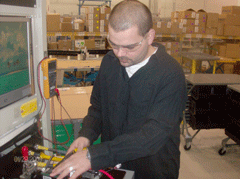
A jump-start for green jobs. Shawn Grimes makes batteries for hybrid vehicles in hard-hit Ohio. (Courtesy of CWA)
GELLERMAN: From the Jennifer and Ted Stanley Studios in Somerville, Massachusetts - this is Living on Earth. I’m Bruce Gellerman, in for Steve Curwood.
The massive economic recovery package Congress is debating could top $900 billion with about $100 billion going for clean technologies, more efficient energy use and mass transit projects.
That’s a lot of green backs. But will they bring back jobs? Living on Earth’s Jeff Young reports on turning the green jobs’ rhetoric into reality.
YOUNG: Pierritte Hopkins was already struggling on low wages and no benefits as a construction worker, and the economy’s slump was making things worse. Then she enrolled in a union group’s program that put her skills to work weatherizing homes for the low income and elderly in Newark, New Jersey.
HOPKINS: Caulking gun, insulation, wrapping fibers, keeping heat in, you know a lot of ‘em don’t have money to pay their bills so we’re really giving them opportunity. And you gotta see their faces afterward, they’re so deeply appreciative. I love their reactions after I do it.
YOUNG: And getting a paycheck ain’t bad either?
HOPKINS: And that’s not bad either (laughs).
YOUNG: Hopkins came to Capitol Hill with a coalition of labor and environmental groups who want the economic stimulus to create more jobs like hers. They want to insulate the bill’s billions in weatherization spending from cuts, steer more money from highway projects and into mass transit, and rev up clean energy investment.
[ORGANIZER AT A RALLY: “AND THEN GROUP SIX WILL MEET WITH ESHOO”, MURMUR OF CONFERENCE ROOM]
YOUNG: Organizers at the “Green Jobs, Good Jobs” conference sent hundreds of advocates on a lobbying blitz to nearly every state delegation. Kirsten Liske wants California lawmakers to make sure her non profit in Santa Cruz, Ecology Action, gets support for energy audits to help small businesses be more efficient.
LISKE: Plugging that money into programs like ours, you’re just immediately going to increase the impact by double or triple with the number of businesses that can be reached. Part of that benefits agencies like ours because we can expand our work. But more so it benefits those small businesses because then you’re leveraging money from utilities and then they end up saving money on their electricity bill.
YOUNG: Advocates say programs like these deserve a spot in the stimulus because they quickly generate jobs, save energy and cut greenhouse gas emissions—a triple play that should appeal to lawmakers. And indeed the House version of the bill has nearly three billion dollars for weatherization. Peter Lehner of the Natural Resources Defense Council says the key to using that money well is to train the workforce.
LEHNER: We’ve got to take these jobs seriously and I think that’s the key part of it. Rather than thinking, oh a green job isn’t a real job. These should be high quality jobs, high paying jobs, and jobs that we understand need training.
YOUNG: A report from the labor and environmental coalition “Change to Win” shows that green jobs haven’t always met those criteria. Many are at or below minimum wage and with poor benefits. Washington Democratic Representative Jay Inslee says the House version of the bill requires projects receiving federal aid to pay prevailing area wages. Inslee says that will face a tough fight in the Senate.
INSLEE: A green job is gonna keep the coastlines from being drowned by global warming. But if we do it right, it’s also gonna keep families from being drowned in debt.
YOUNG: Labor groups also want green jobs to be American jobs. Part of the appeal of jobs insulating homes is that they can’t be outsourced—the work must be done locally. But that’s not necessarily true of green manufacturing. United Steelworkers President Leo Gerard gave a fiery speech at the green jobs conference in defense of so-called “buy American” provisions in the bill that require recipient companies to use US produced iron and steel.
GERARD: The reality is this is about making sure that as we move to the green economy we aren’t putting our jobs up to bid to China where for every unit of production they create one, two, three or four times as much carbon. And we’re not going to be a part of giving away our economic future.
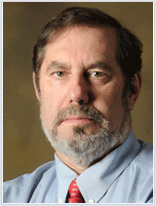
United Steelworkers President Leo Gerard wants green manufacturers to stay in the red, white and blue borders. (Courtesy of USW)
YOUNG: The “buy American” provision is among the bill’s most controversial elements.
Major business groups and European trading partners warn it could spark a trade war. Republican Senator John McCain of Arizona tried to strip the provision on the senate floor.
MCCAIN: It sends a message to the world that the United States is going back to protectionism. We are making a very dangerous move.
YOUNG: McCain’s attempt failed, but the “buy American” battle will rage on as Congress irons out differences in the bill’s House and Senate versions, and President Obama says he’d prefer to keep protectionist language out. Other parts of the bill use less stick and more carrot to keep green manufacturing in the borders. Michigan Democratic Senator Debbie Stabenow pushed for two billion dollars for research into advanced batteries to drive electric vehicles.
STABENOW: Making sure that we don’t move from foreign dependence on oil to foreign dependence on technology. It’s so critical that we are making – making - things here in the green economy.
YOUNG: Most batteries in hybrid vehicles on the road now are imported from Asia. Most—but not all. Shawn Grimes of Ohio makes nickel hydride battery packs for a company called Cobasys near Dayton.
GRIMES: This is the thing, a green job, it’s not something of the fantasy world. I am currently doing it and proudly been doing it and been showing other people, instead of always importing things to America we should build something we can be proud of.

A jump-start for green jobs. Shawn Grimes makes batteries for hybrid vehicles in hard-hit Ohio. (Courtesy of CWA)
GRIMES: Manufacturing’s almost become history in the state of Ohio. We lost the facility that built the Envoys and the Trailblazers, that’s gone now. And that’s a facility we could turn over to make green technology cars here. But they need to invest in the jobs itself and not let it go overseas so we can actually do ‘em and not just talk about ‘em.
YOUNG: There are high hopes here for jobs that do good for the planet and pay well for people. But that effort is now tied to fierce fights over free trade and fair wages. That means those who want more green jobs have a big job ahead.
For Living on Earth, I’m Jeff Young in Washington.
Related links:
- Report on green jobs that don’t always provide good pay
- An analysis of jobs that could be created with clean energy investment
- An analysis of the greenhouse gas reductions possible with the economic stimulus package
Electric Green Jobs
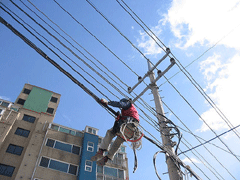
An electrician at work.
GELLERMAN: The stimulus package is designed to shock the economy back to life but that won’t happen without a big jolt of electricity - there are billions in the plan for windmills and solar panels, electric cars, smart meters and a revamped power grid.
All good news for Michael Callanan and the tens of thousands of students he hopes to train to meet the expected shortage of electrical workers. Michael Callanan is the Executive Director of the National Joint Apprenticeship Training Committee. He says the billions to re-power America will provide good prospects for green electricians.
CALLANAN: One of the greatest provisions of the American Recovery and Reinvestment Act and the stimulus package is the allocation of probably about $ 11 billion dollars in grid investment, and one of the key components of that is going to be the transmission line and the development of the transmission line. The stimulus package calls for over 3,000 miles of new transmission line development. To put that in context, since 2000, there’s only been 688 miles of interstate transmission lines developed. So this is going to be a huge challenge for us to be able to get the renewable energy back to where we can use it.

Michael Callanan.
CALLANAN: We have been fundamentally teaching the skills required to do green jobs for years – a number of years. So our focus will be on specifically looking at ways to increase the productivity of these new technologies. For example, wind turbines. The basic skills required to work in wind turbines we’ve been teaching for years, but the nuances of working with these new generations of wind turbines and safety requirements, fall protection, we’ll be focusing and utilizing a boot camp approach. So for those existing workers that have been in the trade for a number of years, we’ll send them to upgrade training and then they’ll work specifically on things like the skills that they need for the particular technology that they’ll be working on. And then we’ll be working on the building efficiencies. I think that should be our primary concern. Forty percent of the total energy consumed in the United States is consumed by the buildings themselves. And so it makes sense to me that we should be focusing on things like building automation, lighting controls, energy efficiency in our ballast, our lamps, those types of projects.
GELLERMAN: So is it conceivable that there’ll be all this money to build these 3,000 miles of, you know, high power lines and the wind mills and the solar panels – all the rest – and we won’t have the electricians to build the infrastructure around it?
CALLANAN: You know, as a colleague of mine is fond of saying, there may be – there will never be a shortage of bodies. What there may be a shortage of is skilled workers. This is just, you know, a demographic issue. There’s just less 20-25, 25-30 year olds in the workplace today. On top of that, I think that we’ve suffered in the construction industry from this mantra over the last ten or fifteen years that your sons and daughters aren’t successful unless they go to college. We’re taking people from flipping burgers one day and the next day we’ve got ‘em into a full-blown four-year career in an apprenticeship system.
The neat thing about apprenticeship systems is if they combine related instruction, classroom training where they’ll work on the theoretical aspects of the trade and on the job training. And I think this is a component that’s been missed. I mean this is a model that dates to the middle ages and it involves earning while you learn potential. For most of these apprentices there’s no tuition to join, there’s no school fees other than buying their books and their tools, and they’re working in the trade, they have a job, and they continue to learn their trade through related instruction in the evenings and weekends and in some cases regular day schools. Graduates of these mid level type programs in our apprenticeship programs on average earn between 45 and 60 thousand dollars a year.
GELLERMAN: So blue collar green jobs.
CALLANAN: Absolutely.
GELLERMAN: Well electrification was the major economic stimulus in the 1930s. And it seems that we’re going to the same well right now. It’s all about electricity.

An electrician on the job.
GELLERMAN: Well thank you very much Mr. Callanan. I really appreciate it.
CALLANAN: Thanks for the opportunity to be on your show.
GELLERMAN: Michael Callanan is executive director of the National Joint Apprenticeship Training Committee.
[MUSIC: Donald Fagan “Green Flower Street” from The Nightfly (Warner Bros 1982)]
GELLERMAN: Just ahead – he’d be 200 years old this month – but we’re still learning new things about the evolution of Charles Darwin’s revolutionary idea. Keep listening to Living on Earth!
Related link:
National Joint Apprenticeship Training Committee
[CUTAWAY MUSIC: Ed Jackson: “Grace” from Colors ]
Gender and Climate Change
GELLERMAN: It’s Living on Earth, I’m Bruce Gellerman.
Climate change is going to affect everyone, but not everyone is going to be affected equally. Women and the poor will suffer most as the intensity of hurricanes, floods, and droughts increases. That’s according to Lorena Aguilar. She’s the Senior Gender Advisor with the International Union for Conservation of Nature. The IUCN is the world’s oldest and largest global environmental network and Ms. Aguilar joins me from her office in San Jose, Costa Rica.
Welcome to living on earth.
AGUILAR: Thank you very much for inviting me.
GELLERMAN: You’ve written extensively about how climate change is far more than an environmental issue. You say it’s a gender issue. How so?
AGUILAR: Well climate change is not only about the change in environment that all of us are suffering. It’s also about the impacts and the way that people are feeling these impacts. The study conducted by London School of Economics, they make an analysis of 141 disasters worldwide. And they were able to prove that in those countries in which gender gaps were bigger or wider, women tend to die more than men. In some countries from every five people that die, four are women and one is man. And this is only related to the condition of being a woman. And when you just analyze the reason why they died, it’s so ridiculous because some of them would have been prevented in simpler ways, like letting them have access to the information on what to do.
GELLERMAN: Well give me some examples. How is disruption of the climate a gender issue?
AGUILAR: For example, I give you the example of Mitch, Hurricane Mitch in Honduras. Women in the coast usually are not sent to school, so when they heard in the radio that winds of 260 kilometers were going to arrive to their coast, they didn’t have any idea what it meant. 260 kilometers – was that too much? Was that too little? We have other countries in Asia, for example, in which women are not allowed to leave their houses without a male relative. And they rather drown in their houses than leave them. So there are many, many other elements. Women are not supposed to learn how to swim, they should not be outdoors, they should remain with their clothes on. So many, many elements that when disaster strikes associated with climate change they’re severely being affected.
GELLERMAN: Here in the United States we had Hurricane Katrina.
AGUILAR: Mmhmm.
GELLERMAN: Did gender play a role in the response or the effect of that hurricane here in the United States, a rich country?
AGUILAR: It did, especially in poor, Afro-American women the effect was a lot, lot harder and bigger than in other communities. They didn’t have access to mobility to get away from the areas, they didn’t know what to do, they hadn’t participated in a lot of these processes, and also to recuperate for single mothers, for example, after Katrina has been extremely more difficult than other people in that area.
GELLERMAN: So in essence what you’re seeing is that climate change magnifies the inequalities that exist now.
AGUILAR: Yes, and at the same time, the inequalities magnify the effects of climate change. So it’s a two-way road in this respect.
GELLERMAN: I know back in what, 2007 at the UN Bali conference on climate change, they set up the Global Gender and Climate Alliance. So what’s that going to do, if anything?
AGUILAR: Well, we tried various twenty-five organizations within the UN system and the international organizations and NGOs to come together to have one voice, one position, to really move forward some of the important issues in relation to climate change and gender.
GELLERMAN: So gender considerations have to be part and parcel of any international climate change agreement.
AGUILAR: Yes, business as usual is not the way to move forward. Nobody can be left out of this big movement that we have to carry out.
GELLERMAN: Well who decided what’s to change?
AGUILAR: Well sometimes the same women and the same men in some of these countries are asking for it. And they are tremendous agents of power. I mean, those that are suffering have the right to say how they want the change. And they’re calling for it, saying that it is not possible that you do not hear us. We are fifty percent of the population. And we have the right to be heard.
GELLERMAN: What about traditional societies, I mean, you’re proposing something fairly radical then.
AGUILAR: Well, when we’re talking about adapting to climate change, we’re introducing all these new things: new ways of planting, new ways of using the forest. All of these might go against some of the traditional ways. But we have to change, and so we’re not very much concerned when we talk about change at the technical level. Why should we be concerned when we talk about change in the way women and men have related to each other and in relation to the environment?
GELLERMAN: So, the whole notion is that climate change can really be a powerful force for social and development change.
AGUILAR: Definitely. I mean, it can be, as we are seeing, a backlash. It is stopping a lot of development. But well taken, it can also be as, you will say, a can opener to improve some of these disparities that we have had for centuries now.
GELLERMAN: Lorena Aguilar is the senior gender advisor with the International Union for Conservation of Nature. Her most recent article “Women and Climate Change” appears in the World Watch Institute’s new book “State of the World 2009”. Ms. Aguilar, thank you very much.
AGUILAR: Thank you.
Related links:
- State of the World 2009
- IUCN
- Global Gender and Climate Alliance (GGCA)
[MUSIC: Vinicius Cantuaria “Sem Pisar No Chao” from Sol Na Cara (Rykodisc 2006)]
Darwin the Abolitionist
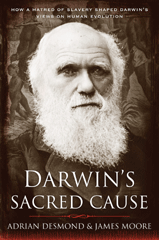
(Courtesy of Houghton Mifflin Harcourt)
GELLERMAN: This month we commemorate the 200th birthday of British naturalist; Charles Darwin. It’s said, Darwin came up with “the single best idea anyone ever had”. He published it in 1859 in his book: On the Origin of Species. Darwin’s unexpectedly popular and controversial idea was that all species of life evolved over time from common ancestors. Darwin’s theory of that process, natural selection, changed the world of science and society at large.
But even today the laws of nature Darwin discovered are still hotly debated and we continue to learn more about the social origins and scientific evolution of Charles Darwin himself. James Moore is co-author of the new book "Darwin's Sacred Cause: How a Hatred of Slavery Shaped Darwin's Views on Human Evolution."
MOORE: All science begins with certain assumptions about the world. Darwin began with certain assumptions. He believed in history. He believed that everything happened slowly, everything happens by natural law. These were first principles, these were given for Darwin. Another given for Darwin was that all the races are members of the same family. This was ingrained in him from childhood. And it’s what led him to theorize about the common descent of all life.
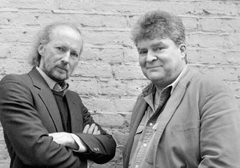
Darwin biographers Adrian Desmond (left) and James Moore. (Photo: (c) Justine Stoddart)
MOORE: Yes, it does. Both Darwin’s grandfathers were passionately committed to abolishing the slave trade, which flourished in that time. And in 1807, two years before Darwin was born, Parliament did abolish trans-Atlantic slave trade. And in America the trans-Atlantic slave trade was outlawed a year later. So Darwin was born into a world in which half the battle had been won. But the slaves remained to be emancipated. And to that end different societies sprang up all of them supported by Darwin’s family.
GELLERMAN: But it’s not until he takes this trip aboard the Beagle that he’s confronted directly with what slave trade really means.
MOORE: Until Darwin reached South America, he had a theoretical understanding of slavery and it’s horrors, but when he got to South America, he put shredded flesh on that slave. He saw the instruments of torture. He heard the screams. And suddenly he became fired as never before that this sin, he called it, should be abolished around the world
GELLERMAN: And from there Darwin sees the horrors of slavery revealed as the trip progresses.
MOORE: He does, you know, outstandingly in Brazil. It’s seared into him. He sees the remnants of slavery and the flotsam of slavery. And at the very end of the voyage, just weeks before the Beagle reaches England, they touch back again in Brazil, and it’s there that Darwin’s walking past a house on the other side of the wall, he hears shrieks and screams, and he thinks to himself, that can only be a slave being tortured. And he was powerless to do anything about it. And when the Beagle got back to Britain, within a few months, he had, within his private notebooks declared himself a believer in common descent of all life.
GELLERMAN: Professor Moore do you think the echo of that scream was as important for what was to come many years later in Darwin’s theory as the species that he collected on his voyager of the Beagle?
MOORE: The scream that stayed with Darwin for life did as much as anything to kick start his belief in the evolution of all life, the common descent of all life. Without the evidence of the Galapagos, we wouldn’t have an argument for evolution by natural selection. But why he went to the trouble and the risk of assembling that evidence and in the way that he did, to understand that we need a deeper explanation. He didn’t collect facts, as they were called, at random. There was a reason for what he did. And his reason had precedence in his own experience and his own family. The scream of a tortured slave, fired him to touch the untouchable and to develop what he called “my theory,” the theory of evolution.
GELLERMAN: I wonder if you might read something from your book. It’s on page 182, and it’s where he’s trading letters with the professor who had been his mentor, in England, Professor Lyle.
MOORE: Oh yes. His greatest eruption ever in print. An absolute moral bombshell he drops in his journal researches about the Beagle voyage: “Those who look tenderly at the slave owner and with a cold heart at the slave, never seem to put themselves into the position of that later. What a cheerless prospect with not even a hope of change. Picture yourself the chance ever hanging over you of your wife and your little children, those objects which nature urges even the slave to call his own, being torn from you and sold like beasts to the first bidder. And these deeds are done and palliated by men who profess to love their neighbors as themselves, who believe in God and pray that his will be done on Earth. It makes one’s blood boil, yet I tremble to think that we Englishmen and our American descendents with their boastful cry of liberty have been and are so guilty.”

(Courtesy of Houghton Mifflin Harcourt)
GELLERMAN: Kind of interesting that at the time that science was used to sustain slavery.
MOORE: Science wasn’t just used to sustain slavery, science was constructed and formulated in such a way that it kept the races together or apart. People had recognized difference amongst themselves from time immemorial. In Darwin’s day, the notion of separate races, separate types of human being, separately created types of human being was claimed to be put on a scientific basis, mainly by measuring people’s bodies.
GELLERMAN: You write a lot about how they would kind of feel the bumps on your head to be able …
MOORE: That’s the proximate source of it, yes, yes. And Darwin in Edinburgh - when he was a student in his teens at Edinburgh University - phrenology, measuring bumps on people’s heads in order to determine their propensities and their character - was absolutely rife. It was a parlor sport, it was also serious science. And in the United States in the 1840s and 1850s, this was considered to be the best progressive, positive science. And Darwin stood foursquare against that movement. All his research in the 1850s was devoted to undermining something that people thought was the latest science.
GELLERMAN: It pits him directly with some of the big wigs in science, particularly in the United States. At Harvard there was Professor Agassiz who’s really a giant. We’re not far from Harvard University right here from our studios and many things are named after him. And Agassiz is really Darwin’s great nemesis.
MOORE: Louie Agassiz was the great popularizer of science in Darwin’s day. He had a fabulous influence. He had an influence in Washington and from Harvard across the country and Agassiz believed that a strong creationist America had to resist the amalgamation of black people with white people because God had created them separately, they must not be brought together. And it frankly revolted him. With all of the authority and prestige of Harvard University, Agassiz maintained this throughout his career there.
GELLERMAN: So the key to debunking the scientific racism of the day was sexual selection. This is during the Victorian era we should say. How did Darwin come up with this theory?
MOORE: Darwin had a theory like no one else had to explain the divergence of the human races, why we look so different to each other. Why some people have very dark skin and others very light, and their eyes are differently shaped and thick lips or thin lips and curly hair or straight hair. All of these things Darwin saw as beauty marks that arose from selection we make in our sexual partners, he calls it sexual selection. You choose people you think are beautiful, and if you choose a man or a woman with particular physical characteristics and have children by that person, the children will resemble the parents. And Darwin says this is exactly what goes on in the breeding of fancy animals.
GELLERMAN: Well he was born 200 years ago. Happy birthday, Charles Darwin. What would you say to him if he were around now?
MOORE: Oh that’s a hard one isn’t it? I would remind him of a statement he made towards the end of his life when asked whether in the progress of mankind we might all become immortal. And he said he thought it very unlikely because if nothing ever died, there wouldn’t be any life at all.
GELLERMAN: Well Professor Moore, it’s been a great pleasure. I really appreciate it.
MOORE: I have enjoyed it too. Thank you so much.
GELLERMAN: James Moore and co-author Adrian Desmond’s new book is Darwin's Sacred Cause.
Related link:
For more on the book “Darwin’s Sacred Cause,” click here
[CUTAWAY MUSIC: Marco Benevento: “Run Of The Mill” from Me Not Me (Royal Potato Family 2009)]
Salt Marsh Diary

Mallards waking up.(Photo:© Salt Marsh Diary)
[MUSIC: Vinicius Cantuaria “Sem Pisar No Chao” from Sol Na Cara (Rykodisc 2006)]
Well, Charles Darwin wanted to visit the United States – but he never did. If he had, we think he would have liked an expanse of river and salt marsh along the coast of Connecticut. It’s about 90 minutes from Manhattan, a place filled with wildlife and wonder for writer Mark Seth Lender.
LENDER: At the bend in the river a flock of mallards is dozing in tall grass that is winter-bleached and battered by snow, by wind, by high water. Worn thin, there is little cover in it but it is all the mallards have and must make do. In these river narrows, in the tie-downs of the straights and shallows, their only true refuge is day sleep. The pulse drops, the body stops except for the low breath and the least heat it needs to keep on living. Even the sun is cold. And the mallards hold.
They are an average flock, these mallards. Still as the ice grounded to the bank. Closest are four drakes, laid up with their bills tucked to the crook at the back of their necks. Positioned this way their heads are a virtual black so dark it is not a color but a gap. Sensing my presence the drakes, in consort, look up. And a curious thing. That gap fills with an iridescence, so brilliant, reminiscent more of a scarab’s shell than the soft hue of feathers.
It is the angle between the shafts. Heads bent, the feathers spread. Light falls straight in and vanishes. Only when the drakes unfurl themselves do the feathers relax and close and the full green flash of plumage, bright as a lighthouse, beacons forth. The object of all this stands between them, a single hen, invisible as an afterthought. Movement reveals her and (now that she is standing) so do her very orange feet. The color is a sign that breeding is imminent, though the choosing is not yet complete. It is for her the drakes risk themselves this way and hide as best they can when they sleep. For the need runs deep and the mallards stay.
.gif)
Mallards dozing. (Photo:© Salt Marsh Diary)

Mallards waking up. (Photo:© Salt Marsh Diary)
I want to lie down beside them there on the spongy bank, nestle my face into the warm hollows of their wings and feel the pulse and listen to them breathe. But I must leave. Not out of fear nor because I am riven by the frigid air and not because I want to. I am comforted here. As if I belong here. As I am sure we used to before we knew what we know and wish we did not.
GELLERMAN: Mark Seth Lender writes a syndicated column called “Salt Marsh Diary.” He also takes photographs of the place – you can see some at our website, loe.org.
[MUSIC: Marco Benevento “Sing It Again” from Me Not Me (Royal Potato Family 2009)]
GELLERMAN: Just ahead: burn baby burn – wood keeps houses warm and snug – but ignites a firestorm of controversy - Stay tuned to Living on Earth.
ANNOUNCER: Support for the Environmental Health Desk at Living on Earth comes from the Cedar Tree Foundation. Support also comes from the Richard and Rhoda Goldman fund for coverage of population and the environment. And from Gilman Ordway for coverage of conservation and environmental change. This is Living on Earth on PRI, Public Radio International.
Related link:
Salt Marsh Diary
[CUTAWAY MUSIC: Marco Benevento: “Run Of The Mill” from Me Not Me (Royal Potato Family 2009)]
Burning Controversy
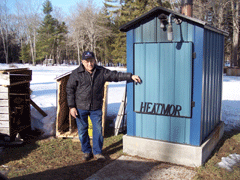
Roland Morin stands by the outdoor wood boiler he and his wife use to heat their home. (Photo: Bruce Gellerman)
GELLERMAN: It’s Living on Earth. I’m Bruce Gellerman
The state of Maine claims to be the birthplace of America’s timber industry and fabled lumberjack Paul Bunyan.
[MUSIC: PAUL BUNYAN]
GELLERMAN: In Bangor you’ll find what’s maybe the world’s largest statue of the mythic woodsman. In Maine, it’s not just a tall tale. 90 percent of the Pine Tree State is forested. It’s the highest percentage in the nation. The state seal and flag both feature a White Pine. The roots of forestry run deep in the hearts and minds of Mainers.
DURGIN-LEIGHTON: It’s tradition…it’s part of our culture.
GELLERMAN: Kathy Durgin-Leighton is town manager of Bowdoinham, Maine.
DURGIN-LEIGHTON: Wood is a natural resource here. We have plenty of it. People make their living logging. It’s just a way of life here. I think that if you went down any country road in Maine you’d see a woodpile.
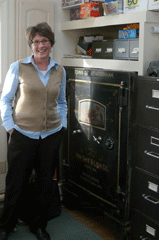
Bowdinham town manager Kathy Durgin-Leighton says talk of regulating outdoor wood boilers divided the community. (Photo: Bruce Gellerman)
GELLERMAN: There are half a dozen woodpiles behind Roland and Dorina Morin’s home in Brunswick Maine.
[WALKING ON SNOW]
GELLERMAN: The Morins have 75 acres of trees. Roland built their home with lumber from the trees. Out back, along the fence line, are neatly stacked cords of dry-split wood – mostly pine and a little hardwood.
GELLERMAN: What a nice day!
ROLAND MORIN: Yup, beautiful day.
[WALKING ON SNOW]
GELLERMAN: It’s mid winter—the air is crisp, the sky blue, and the white pines soar in the Morin’s back yard. It’s quintessential New England.
[WALKING ON SNOW]
GELLERMAN: Outside it’s an unseasonably warm 45 degrees. Inside the Morin home it’s a toasty 75 – thanks to the outdoor wood boiler Roland installed about 50 feet behind their house. It’s in a metal shed with a 12-foot high smokestack poking out of the top. The wood boiler looks a little like an outhouse.

(Photo: Bruce Gellerman)
GELLERMAN: Sure.
ROLAND MORIN: Just stand back a little bit – there might be smoke coming out.
[DOOR BANGING SHUT]
GELLERMAN: Outdoor wood boilers are relatively new devices. They’ve been around about a dozen years. Roland Morin’s wood boiler fire box is surrounded by a metal water-jacket. The burning wood heats the water, which is piped underground into his home.
GELLERMAN: And this fire, this little firebox, here, heats your entire house?
ROLAND MORIN: Oh yes. It could heat two or three that size. It doesn't take that much heat to heat the house.
[BANG OF DOOR OPENING]
GELLERMAN: So on a day like this, would you be burning much wood?
ROLAND MORIN: No, no, it doesn’t burn much. Especially as warm as it is, hardly at all.
[STEEL DOOR CLOSING]
GELLERMAN: In the 1960’s, the Morins were paying 13 cents a gallon for fuel oil. But a few years ago, after the textile mill in town shut down, and Roland lost his job, he and Dorina decided to replace their old oil furnace with an outdoor wood boiler.
DORINA MORIN: We like it very, very much.
GELLERMAN: Dorina Morin says they like their wood boiler so much, two of their sons, who live just down the road, also bought them.
DORINA MORIN: It’s all outside and the heat is very steady. We don’t worry about any heat. And it also heats our hot water.
GELLERMAN: Because the boiler is outside, there’s no wood mess inside the Morin’s house. And Roland has made a few special modifications to the wood boiler – so it burns clean.
[BANGING OF WOOD BOILER]
ROLAND MORIN: When it's idling properly there's hardly any smoke whatsoever.
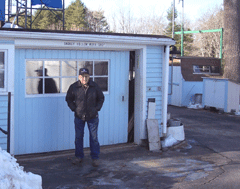
Roland Morin stands by his Work Shop next to his home in Brunswick, Maine. (Photo: Bruce Gellerman)
ROLAND MORIN: This boiler here is known as the dirtiest boiler in Maine.
[METAL CLANK]
GELLERMAN: Yeah, so do you earn your reputation, do you deserve that reputation?
ROLAND MORIN: Oh yeah. [LAUGHS.] No. No, I don't deserve it.
WELT: It was choking, pungent, acrid odors.
GELLERMAN: Jeff Welt lives 500 feet down the road and downwind from the Morin home and their outdoor wood boiler:
WELT: We were smelling pretty heavy fumes, I mean it would wake us up at nights, we'd have headaches, there’d be nausea. So we can't keep our windows open. We do a lot of things traditionally, like hang our clothes out to dry – we don't like to use a dryer – stopped doing that. We have a big garden back here, and we were really concerned last year about whether we should be eating food out of the garden.
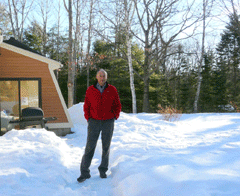
Jeff Welt says fumes from his neighbors’ outdoor wood boiler give him headaches and nausea. (Photo: Bruce Gellerman)
GELLERMAN: Dorina Morin doesn’t understand her neighbor Jeff Welt’s problem.
DORINA MORIN: And, I also in the spring and the fall, I hang out my clothes. And I take them in. They don't smell smoke.
GELLERMAN: Good fences may make good neighbors but when it comes to wood smoke from outdoor boilers, Jeff Welt found, fences aren’t much help.
WELT: And then my neighbors started calling, the neighbors who live up and down the street, and they pass here on the way to work or they jog by or something, and they’re saying it's gross.
GELLERMAN: Again, Roland Morin:
ROLAND MORIN: They complain so much, every complaint brings someone else to say that this furnace is bad.
WELT: People are not allowed to dump poison waste on my property. They're not allowed to poison the water that we drink. But meanwhile they're contaminating, poisoning the air that we breathe. That shouldn't be allowed.
GELLERMAN: But in most places wood boilers are allowed – and their number is growing dramatically nationwide.
RECTOR: We saw an exponential growth as oil prices began to rise.
GELLERMAN: Lisa Rector is a senior policy analyst with NESCAUM, the Northeast States for Coordinated Air Use Management, which represents air quality agencies in six states. Just three years ago, Rector says, there were about 150 thousand outdoor wood boilers in the United States. Today there are a quarter of a million and she predicts the number will soon double.
RECTOR: We estimated that, left unchecked, and sales trends continue there would be half a million in place in 2010.
GELLERMAN: The reason wood boilers are so popular these days is simple.
DOUG THOMAS: Let's look at the big picture. Ok?
GELLERMAN: It’s money, says Maine representative Doug Thomas. His district is one of the poorest in the state, and wood boilers are popular there.
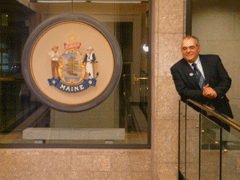
Maine representative Doug Thomas with the state seal, which features the white pine. (Photo: Bruce Gellerman)
GELLERMAN: And in Maine, the natural alternative to skyrocketing oil prices is wood. Wood is plentiful. It’s renewable – and if you replace downed trees with new ones, it’s carbon neutral.
But burning wood can also be deadly.
RECTOR: A lot of people think of wood smoke as that smell of Christmas. But in general, actually wood smoke is a fairly toxic substance.
GELLERMAN: Lisa Rector of NESCAUM says wood boilers are by far, the dirtiest way to heat a home.
RECTOR: One outdoor wood boiler, the emissions, the PM emissions, the particulate matter emissions from these units is equivalent to 205 oil furnaces and three to eight thousand natural gas fired furnaces, or it’s equivalent to about 50 idling diesel trucks. So it’s like having a truck stop in your backyard.
GELLERMAN: Rector says particularly troubling are the fine microscopic particles in smoke, specks so small they can lodge deep in your lungs.
RECTOR: Those particles, even if your doors are closed, your windows are closed, they’ll still find their way into the house. Those particles cause cardio-pulmonary issues, asthma. They can be especially be of risk to sensitive populations such as children, the elderly, those with asthma. So wood smoke is not a benign substance. It is actually the largest sources of fine particles in North America today.
GELLERMAN: Fine particulates in the air kill 60 thousand Americans a year – more than die in auto accidents. And besides fine particulates there are other toxic pollutants in wood smoke and creosote which builds up in smoke stakes, volatile organic compounds, polyaromatic hydrocarbons and dioxins, some known carcinogens.
GELLERMAN: Armed with this information, Jeff Welt in Brunswick, Maine, who lives near a wood boiler, decided to take action.
WELT: Twenty of my neighbors signed a petition that we sent to the state, saying it's adversely affecting the enjoyment of the neighborhood. You know – do something about it.
GELLERMAN: But there was nothing the State of Maine could do. Back in 2006 when Welt complained to state officials, there were no laws regulating outdoor wood boilers – not federal, state, or local. Wood boilers pit neighbor against neighbor and town against town. As the number of wood boilers increased, so did complaints. Lisa Rector of NESCAUM fielded many of them.
RECTOR: In many cases, and I’ve heard of them personally, people have called me looking for help. They’ve gone to their local town officials, their state officials, and there really is no regulatory avenue to address these.
GELLERMAN: Jeff Welt convinced officials in Brunswick, Maine, to pass an ordinance limiting wood boilers. New ones were banned in Brunswick, but old ones were allowed to remain, their use restricted to winter. A few other towns in Maine also approved ordinances restricting wood boilers, but most didn’t, and Lisa Rector says, people in those places affected by wood boiler smoke, had little recourse:
RECTOR: So they are required to either live with the situation, move, or bring a lawsuit and try to address it through private party nuisance lawsuits.
BETH THOMAS: And I said I’m not suing my neighbor. I’m not going to do that.
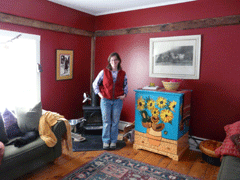
Beth Thomas moved to town that bans outdoor wood boilers. (Credit: Bruce Gellerman)
BETH THOMAS: I would be out in garden getting these headaches, intense headaches, and it would get hard to breathe. And if it were really bad, and the creosote-based smoke was coming into the house itself, which happened frequently, I would just put the kids in the car and go.
GELLERMAN: So, what did you do?
BETH THOMAS: What did I do. I called everybody I could find that I knew who might have some control or some information about this, and uh, from the Air Toxics to the Air Bureau to the – everybody – and the only thing people could say was, there's a nuisance law – you can sue them. Or you can move – that was the other thing. You can move.
GELLERMAN: Thomas’s lawsuit went nowhere. So she tried to get Bowdinham to regulate the boilers. At town meeting, the debate was intense. Town Manager Kathy Durgin-Leighton says it was about the most controversial issue in Bowdinham history.
DURGIN-LEIGHTON: It really divided people. It became quite a divisive issue. It was clear that the citizens of this town did not want to enact an ordinance that would limit or prohibit the use of outdoor wood boilers.
GELLERMAN: Why is that?
DURGIN-LEIGHTON: I think it was a statement of their rights to burn wood.
BETH THOMAS: We’re not after wood burning rights. That’s silly.
GELLERMAN: Again, Beth Thomas:
BETH THOMAS: I mean I grew up in Maine – we're wood burning people. This is what I was trying to tell neighbors, and it just – it fell on deaf ears. I'm all for emissions control. What comes out of that stack needs to be filtered.
GELLERMAN: When Bowdinham residents voted to keep wood boilers unregulated, Thomas moved to Hallowell, Maine, a town that banned them. Hallowell is just south of the capitol, Augusta. There, Beth Thomas filed a complaint with officials demanding something be done on the state level to replace the patchwork of local ordinances. State lawmakers were reluctant to take up the issue.
BERRY: I couldn’t believe that burning wood could possibly be a health threat.
GELLERMAN: State Representative Seth Berry became an unlikely champion of state limits on outdoor wood boilers – his father has one at his home. But one whiff of a poorly run wood boiler was all Berry needed to change his mind.
BERRY: If you walk through a cloud of creosote smoke, you know it, and your friends know it for the rest of the week because you can’t wash it out of your hair.
GELLERMAN: Berry became a man with a mission. His colleagues in the Maine legislature began calling the freshman lawmaker: Boiler Boy. Berry held hearings – angry, contentious meetings that drew huge crowds.
BERRY: These folks had been told that we were trying to take away their wood boilers and so they were given stickers, bright, fluorescent stickers, saying, ‘Don’t take away my right to burn wood,’ and they lined the halls of the legislature. And by the end of the hearing, once the technical information came out, once the personal stories of folks who lived next to certain problematic boilers came out, many people who had come that day to wear those stickers were taking the stickers off.
GELLERMAN: Berry’s emergency bill – phasing in limits on emissions and where wood boilers can be installed was passed overwhelmingly by Maine’s legislature, and now Maine joins Connecticut and Vermont with laws regulating outdoor wood boilers. Ohio and other states are considering similar measures, and years ago, Washington State banned them all together.
And that’s what Maine representative Doug Thomas fears will happen in his state. Thomas was the major opponent to Seth Berry’s bill. And until it passed, he sold outdoor wood boilers.
DOUG THOMAS: I really don't want to sell them anymore because, the way these regulations that Maine is writing are, it's going to be complaint-driven enforcement. And so I might sell someone a six or eight thousand dollar wood boiler, and they've got another four or five thousand dollars to install them and they can't use. I don't want to do that to people. I'm not going to do it to people.
GELLERMAN: The federal government has been slow to respond to the wood boiler issue. Twenty years ago the US EPA began regulating indoor wood stoves, setting strict emission standards for them. And, in fact, Beth Thomas, who had to move because she lived near a polluting outdoor wood boiler has one of the new indoor stoves right in the living room of her home.
But she’s in the minority. Despite federal regulations, 90 percent of the estimated ten million indoor wood stoves in the US fail to meet emission requirements. The clean ones just haven’t caught on. That’s why Greg Green, from the EPA’s Office of Air Quality and Standards, hopes to speed things up with boilers. Instead of requiring new cleaner-burning wood boilers, The EPA is setting voluntary guidelines.
GREEN: You know, many times, our regulatory programs, by the time you go through the rule-writing process, and actually implement those rules, you're talking about a four or five year time period. But with the problems that we were seeing with these stoves, uh, with a voluntary program, uh, we realized that we could more than cut that time in half and start seeing emissions reductions, you know, in a one or two-year time period. So that's what we went with.
GELLERMAN: The EPA’s new guidelines for outdoor wood boilers went into effect a year ago, and manufacturers have started making cleaner burning wood boilers. Rodney Tollefson is vice president of Central Boiler. It’s the nation’s largest manufacturer. He says their new models cut emissions by as much as 90 percent over the old ones.
TOLLEFSON: We actually have people that have installed them and in one case we know of, the neighbor questioned this guy, “When are you going to get this thing running?” and the furnace had been running for almost a week and they didn’t even know it was operating.
GELLERMAN: The new, cleaner burning wood boilers are considerably more expensive, and they haven’t been proven in the marketplace or backyards. But Maine state representative Doug Thomas isn’t giving up on wood boilers.
DOUG THOMAS: The technology has its place. It's not for urban areas, it's not for built-up areas, residential areas. It's for rural people who have land, and have access to wood that would otherwise be going to waste, and it's a great alternative source of heat for the right people in the right place.
[MUSIC ON PLAYER PIANO: "Rudolph the Red-Nosed Reindeer"]
GELLERMAN: Back in Brunswick, Maine, Roland Morins has finished loading logs into his outdoor wood boiler. It warms the home, where he, Dorina, and their ten kids lived through many a long cold Maine winter.
In the living room Roland relaxes by putting a scroll on their old player piano. It’s a scene of a time gone by, in a place where the white pines still grow incredibly high. But these days, the neighbors live closer than they used to – and yet in many ways, they’re more distant.
[MUSIC ON PIANO-PLAYER]
Related links:
- EPA Information on Outdoor Wood Boilers
- Northeast States for Coordinated Air Use Management
- Central Boiler, Inc.
GELLERMAN: Our story about outdoor wood boilers was produced with the help of Kathleen O’Neil.
Living on Earth is produced by the World Media Foundation. Our crew includes Ashley Ahearn, Bobby Bascomb, Eileen Bolinsky, Ingrid Lobet, Helen Palmer, Mitra Taj and Jeff Young, with help from Sarah Calkins and Marilyn Govoni. Our interns are Lindsay Breslau, Liz Gross and Christine Parrish. Jeff Turton is our technical director. Alison Lirish Dean composed our themes. You can find us anytime at loe.org. Steve Curwood is our executive producer.
I’m Bruce Gellerman. Thanks for listening.
ANNOUNCER: Funding for Living on Earth comes from the National Science Foundation, supporting coverage of emerging science, and Stonyfield Farm: organic yogurt and smoothies. Stonyfield pays its farmers not to use artificial growth hormones on their cows. Details at stonyfield.com.
Support also comes from you our listeners, the Ford Foundation, the Town Creek Foundation, the Oak Foundation supporting coverage of climate change and marine issues; the Skoll Foundation, supporting social entrepreneurs around the world – uncommon heroes dedicated to the common good. Learn more at skoll.org; and Pax World Mutual Funds: socially and environmentally sustainable investing. Pax World: for tomorrow. On the web at paxworld.com.
ANNOUNCER: PRI, Public Radio International.
Living on Earth wants to hear from you!
Living on Earth
62 Calef Highway, Suite 212
Lee, NH 03861
Telephone: 617-287-4121
E-mail: comments@loe.org
Newsletter [Click here]
Donate to Living on Earth!
Living on Earth is an independent media program and relies entirely on contributions from listeners and institutions supporting public service. Please donate now to preserve an independent environmental voice.
NewsletterLiving on Earth offers a weekly delivery of the show's rundown to your mailbox. Sign up for our newsletter today!
 Sailors For The Sea: Be the change you want to sea.
Sailors For The Sea: Be the change you want to sea.
 The Grantham Foundation for the Protection of the Environment: Committed to protecting and improving the health of the global environment.
The Grantham Foundation for the Protection of the Environment: Committed to protecting and improving the health of the global environment.
 Contribute to Living on Earth and receive, as our gift to you, an archival print of one of Mark Seth Lender's extraordinary wildlife photographs. Follow the link to see Mark's current collection of photographs.
Contribute to Living on Earth and receive, as our gift to you, an archival print of one of Mark Seth Lender's extraordinary wildlife photographs. Follow the link to see Mark's current collection of photographs.
 Buy a signed copy of Mark Seth Lender's book Smeagull the Seagull & support Living on Earth
Buy a signed copy of Mark Seth Lender's book Smeagull the Seagull & support Living on Earth

